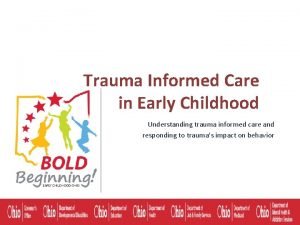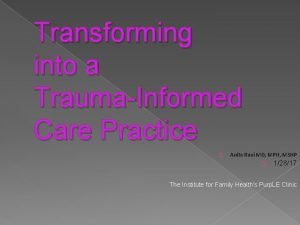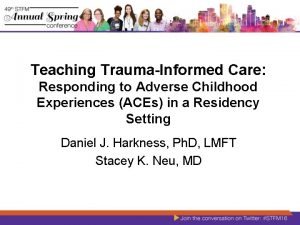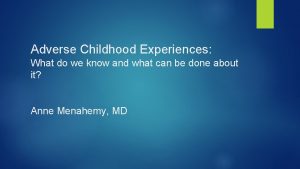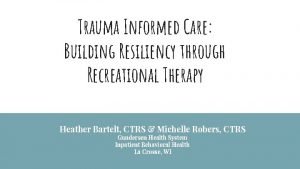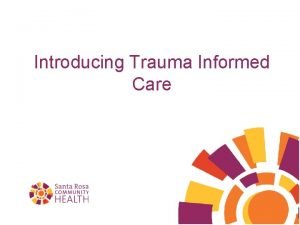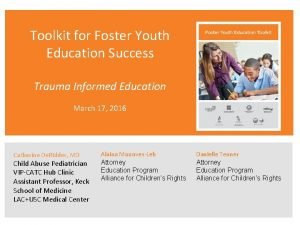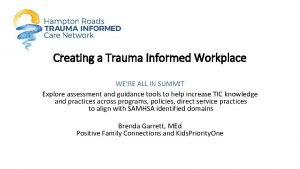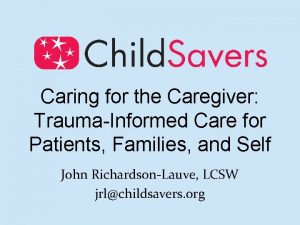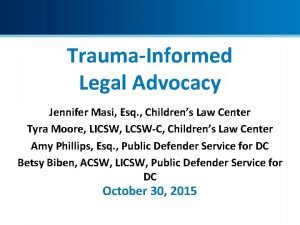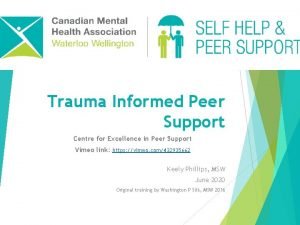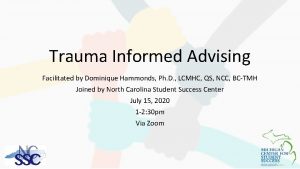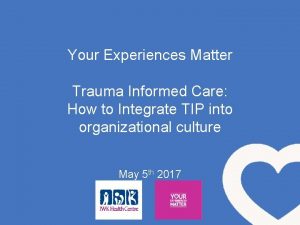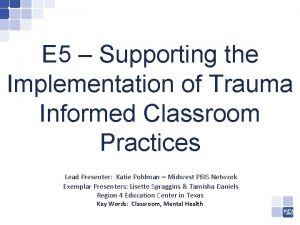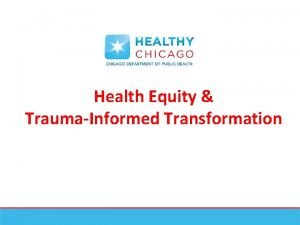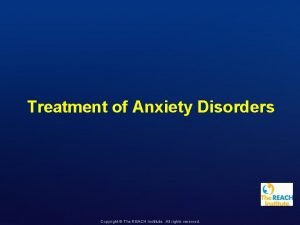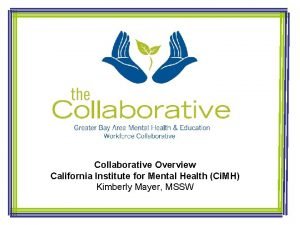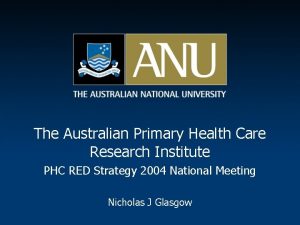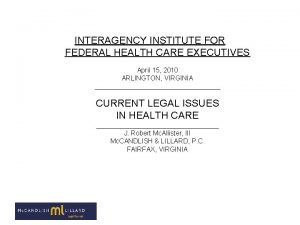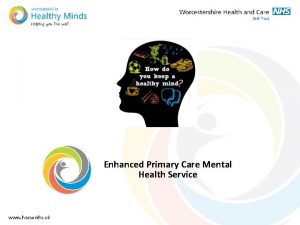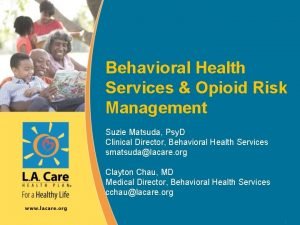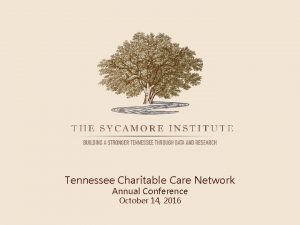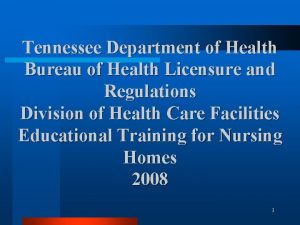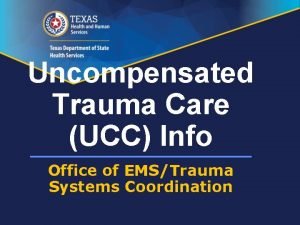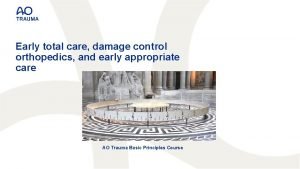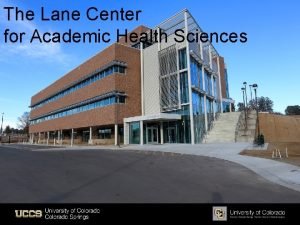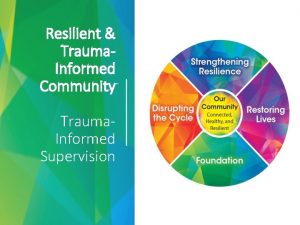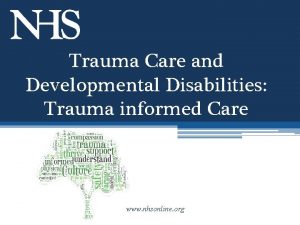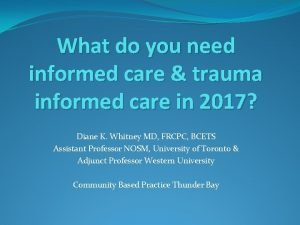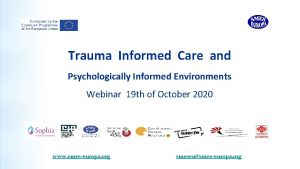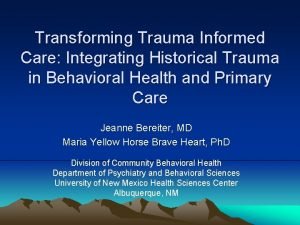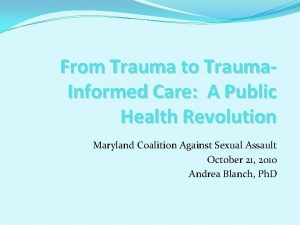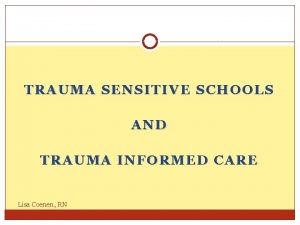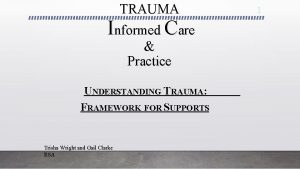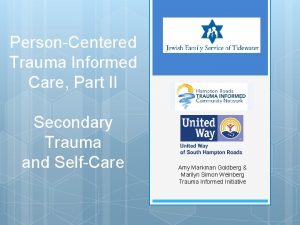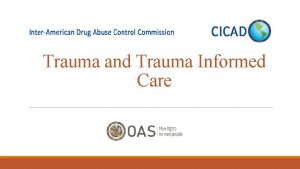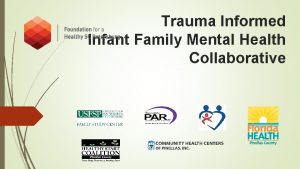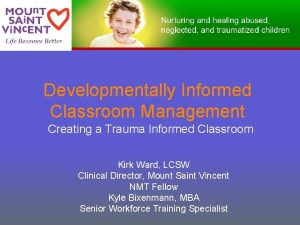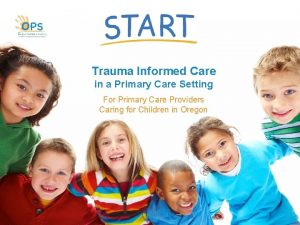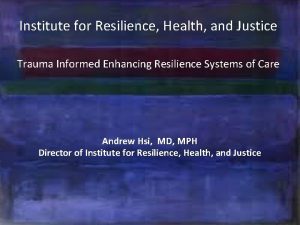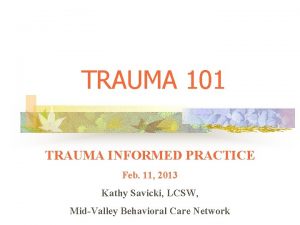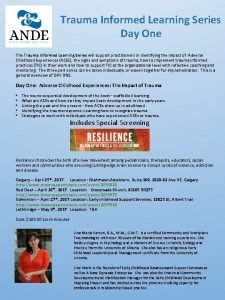MIDDLE TENNESSEE MENTAL HEALTH INSTITUTE Trauma Informed Care




































- Slides: 36

MIDDLE TENNESSEE MENTAL HEALTH INSTITUTE Trauma Informed Care 1

OVERVIEW What is Trauma The Prevalence of Trauma Identifying and Assessing Trauma The Use of Universal Precautions Why Trauma Informed Care is Important MTMHI and our STATs Related to T. I. C. Phase I – Introduction of T. I. C. Phase II – Braking the Cycle Lessons Learned Phase III – Moving Forward 2

Trauma - Trauma is the experience of violence and victimization including severe neglect, sexual abuse, physical abuse, domestic violence and / or the witnessing of violence. (NASMHPD, 2006) - A Trauma Informed Environment supports the needs of both patients and staff who have either experienced trauma or worked with trauma. (MO Dept. of Mental Health 2014) 3

Prevalence of Trauma 51% of the general population have experienced trauma in childhood. (CDC, 2013) 80 % of female offenders with a mental illness report having been physically or sexually abused. (Marcenich, 2009) 75% of those in treatment for substance abuse report a trauma history. (SAMSHA/CSAT 2000) 4

IDENTIFYING TRAUMA Trauma informed work requires the use of informed lenses. Traumatic events are not usually readily disclosed. We must ask and take the time to know our patients. 5

Assessing Trauma Adverse childhood experiences (ACEs) are stressful or traumatic experiences, including abuse, neglect, witnessing domestic violence, growing up with substance abuse, mental illness, parental discord, or crime in the home. An ACE score is a tally of 10 questions related to these stressful or traumatic experiences. The higher your score the higher your risk. Four or more ACEs have been linked to an increase chance of health problems, depression, domestic violence, drug use, and suicide. (Hodas, 2005) 6

How do ACEs impact adults - ACEs can affect an individuals physical and emotional health throughout the life span. - They disrupt neurodevelopment which induces Social, Emotional, and Cognitive Impairment……… TRAUMA (CDC 2000) 7

How does this effect us? We need to presume ALL our clients have a history of traumatic stress and exercise Universal Precautions. - Treat all clients as if they have trauma. We do this by creating a system of care that is traumainformed. (Hodas, 2005) 8

WHY TRAUMA INFORMED CARE? � � � The trauma-informed approach has become a central focus in multiple service sectors. This standardized concept serves to advance an understanding of trauma and a trauma –informed approach to care. The use of Trauma Informed care prevents us from retraumatizing our patients. 9

A TRAUMA INFORMED APPROACH MTMHI began implementing a Trauma Informed care approach to our delivery system in 2013. It is not a program model but a continuum of care initiated in phases. Our goal is to improve patient care by cultivating staff that is Aware, Sensitive, and Responsive to our patients trauma and needs. It has become a profound paradigm shift within the organization 10

WHAT IS T. I. C. Purpose - To ensure we do no harm - To develop a common framework - Improve services by increasing awareness of trauma Creating A Culture - Safety: Is it safe? - Respect: Am I showing respect? - Trust: Does it build trust? 11

Roadmap to Success Intervening at first sign(s) of distress Identifying triggers De-escalate Offering Choices Giving away CONTROL to gain CONTROL No power struggles Do Not argue 12

Challenges of T. I. C. In the Forensic Environment - Unavoidable triggers: bright lights, overcrowded, violence prone, body search, room searches, restricted movement ……etc. - Triggers can increase trauma related behaviors. - Introduction of T. I. C. minimizes triggers, stabilizes patients, de-escalates situations, decrease patient & staff injury, reduce incidents and seclusion/restraints. 13

Benefits of T. I. C. � Patients protection against re-traumatizing, significant decrease in S/R, significant decrease in injuries, reduced LOS, improved treatment outcomes, decrease in recidivism � Staff significant decrease in injury, improved teamwork, increase in skill set, job satisfaction, and reduction of secondary trauma 14

SECONDARY TRAUMA 15

Enhancing Staff Wellness Initiate a T. I. C. approach Train and retrain staff in T. I. C. Improve staff retention and job satisfaction Incorporate Trauma Informed approaches into policies Make secondary Trauma a part of our environment - Talk about it - Address initial and secondary trauma - Offer and encourage help to staff - Employee Assistance Programs - Offer a daily wellness walk - Use of our Gym and Exercise Program 16

MTMHI - a look at WHO WE ARE and some of our STATISTICS 17

TENNESSEE DEPARTMENT OF MENTAL HEALTH & SUBSTANCE ABUSE SERVICES MIDDLE TENNESSEE MENTAL HEALTH INSTITUTE MAIN FORESNSIC SERVICE SERVES 18 COUNTIES SERVES THE ENTIRE STATE Average Annual Admissions: 170 - AVERAGE DAILY CENSUS BY PROGRAM (3) ACUTE UNITS: 26 (4) EXTENDED UNIT: 25 (1) FORENSIC UNIT: 18 30 bed free standing maximum security facility consisting of: Evaluation Unit - pre-trial and posttrial forensic patients requiring an evaluation and/or treatment for competency Treatment Unit - transfers from other RMHIs requiring a more secure placement due to unmanageable, aggressive or violent behaviors 18

August 2015 – July 2016 Data ADMISSIONS = 3, 970 (Acute and Forensic) Average Daily Census = 160 AVERAGE TURNAWAY RATE = 17 % AVERAGE ADMISSIONS PER DAY = 11 AVERAGE DISCHARGES PER DAY = 10 AVERAGE 30 DAY READMIT RATE = 11% AVERAGE OCCUPANCY RATE = 90 % AVERAGE (LOS) ACUTE TREATMENT = 4 days 19

AVERAGE SECLUSION AND RESTRAINT 600 MINUTES PER MONTH 2014 - 2016 494 500 400 2014 300 2015 200 100 0 2016 162 61 67 Seclusion 82 81 Restraints 20

PROGRAM SPECIFIC S/R AVERAGE MINUTES PER YEAR 2014 - 2016 600 555 424 400 2014 300 229 200 100 0 163 88 FSP 95 40 68 75 ATP 36 73 ETP 2015 2016 48 ALL 21

ORYX and HBIPS 1 st Quarter of 2016 (Jan – Mar) ORYX On 12 of 15 measurements MTMHI was lower than the national average HBIPS On all 18 measurements MTMHI was lower than the national average 22

PHASE I: Goal Reduce Our Patients’ Trauma 23

Getting Started Performance Improvement Team - Analyze facility wide data on S/R - Design TIC training program for staff - Utilize MTMHI intranet for TIC awareness/training - Incorporate TIC into NEO and Annual Training - Communicate information about our successes - Devise strategies to reduce S/R 24

OTHER BENEFITS GAINED 1. 2. 3. 4. 5. 6. 7. 8. 9. Reduction in patient injury Improvement in patient satisfaction surveys Decreased length of stay Decreased recidivism Reduction of staff injury Enhanced therapeutic skill set for staff Improved employee job satisfaction Spawned TIC training at all R. M. H. I. s Development of a more therapeutic treatment milieu 25

PHASE II - BREAKING THE CYCLE 26

PEER SUPPORT SERVICES -SAMSHA grant TNDMHSAS dept. oversight TMHCA community collaboration Role of CPRS -TIC training for staff Peer perspective Veteran peer perspective Peer Support Specialist NEO -WRAP groups Creating wellness/recovery culture -PRS certification for staff Employee(s) pursuing CPRS -BRIDGES groups Functional skills for success in recovery -WRAP for staff -Patient(s) pursuing CPRS post discharge 27

Restructuring Programming Acute Treatment Mall -Group Modules System simplified scheduling increased safety individualized treatment improved documentation -AA/NA Meetings led by PRS -Weekend Treatment Mall programming on units staffing utilization -Family Support Group Extended Treatment Mall -Anger Management communication skills -Wellness/Recovery led by PRS -Pet Therapy -Life Skills functional and practical focus for community reintegration -Art and Music Therapy increased offerings 28

STAFF EDUCATION - Quarterly: TIC training - Quarterly: Community training - NEO & Yearly CCM - LGBTI Treatment Training - Group Leader Training - Individual Employee Training - Employee Coaching - Suicide Prevention - Stigma of Mental Illness - Mental Illness & Addiction 29

Lessons Learned 30

Work Smarter not Harder - - It is not just about training T. I. C. to employees Access external assistance ASAP 1. Improves training 2. Lessens financial and resource burdens Things we should have implemented sooner: 1. Staff with lived experience 2. Use incidents as an opportunity for education/training vs. disciplinary 3. Community integration program 4. Unit specific patient activities 31

Keys to Success - Must have proactive support from Leadership - Trainers must receive education and training initially and whenever possible - Persevere through resistance to change - Train staff to work as a team when responding to “crisis” - Utilize a crisis intervention training program (CPI, Mandt, CCM) with a refresher at least annually - Hone de-escalation skills 32

View S/R as a Treatment Failure - Re-traumatizes the patient - Promotes an atmosphere of CONTROL - Cultivates a stressful (“hostile”) environment - Compromises therapeutic culture of safety, respect, and trust - Following S/R therapeutic relationship must be rebuilt 33

PHASE III - Moving Forward 34

Plan for Continued Success � TIC Leadership Team � Identify TIC Champions � Incorporate TIC in our P&Ps � Modifications to Environment � Continue to Involve Community Resources � MTMHI Mission and Vision to include TIC � Increase Caregiver Support � Share our Knowledge 35

Recipe For Your Success � Mold it to your organization � Promote the vision from key leadership � Find your CHAMPIONS � Train – Educate – Role Model � Identify your full scope of resources � Continually measure its effectiveness � Change is HARD – support your staff 36
 2016494500
2016494500 4 r's trauma informed care
4 r's trauma informed care Trauma informed care lgbtq
Trauma informed care lgbtq 4 r's trauma informed care
4 r's trauma informed care Trauma-informed care cheat sheet
Trauma-informed care cheat sheet 4 r's trauma informed care
4 r's trauma informed care Family enhancement center
Family enhancement center Tina champagne sensory modulation and environment
Tina champagne sensory modulation and environment Trauma informed practice
Trauma informed practice Trauma-informed care activities for staff
Trauma-informed care activities for staff Trauma informed care for foster youth
Trauma informed care for foster youth Trauma informed workplace
Trauma informed workplace Trauma-informed questions for clients
Trauma-informed questions for clients Trauma informed legal advocacy
Trauma informed legal advocacy Kobtion
Kobtion Trauma informed advising
Trauma informed advising Acessexual
Acessexual Trauma informed practice
Trauma informed practice Trauma infromed
Trauma infromed Trauma informed practice
Trauma informed practice Reach institute mental health
Reach institute mental health California institute for mental health
California institute for mental health Chapter 20 mental health and mental illness
Chapter 20 mental health and mental illness Jeopardy mental health
Jeopardy mental health Australian primary health care research institute
Australian primary health care research institute Interagency institute for federal health care executives
Interagency institute for federal health care executives Enhanced primary care mental health
Enhanced primary care mental health Beacon mental health la care
Beacon mental health la care Tennessee charitable care network
Tennessee charitable care network Tennessee department of health licensure
Tennessee department of health licensure Tennessee division of radiological health
Tennessee division of radiological health Primary, secondary, tertiary care
Primary, secondary, tertiary care Unit 2 equality diversity and rights
Unit 2 equality diversity and rights Dshs uncompensated trauma care application
Dshs uncompensated trauma care application Early total care in trauma
Early total care in trauma Health and social care component 3
Health and social care component 3 Uccs health center
Uccs health center

